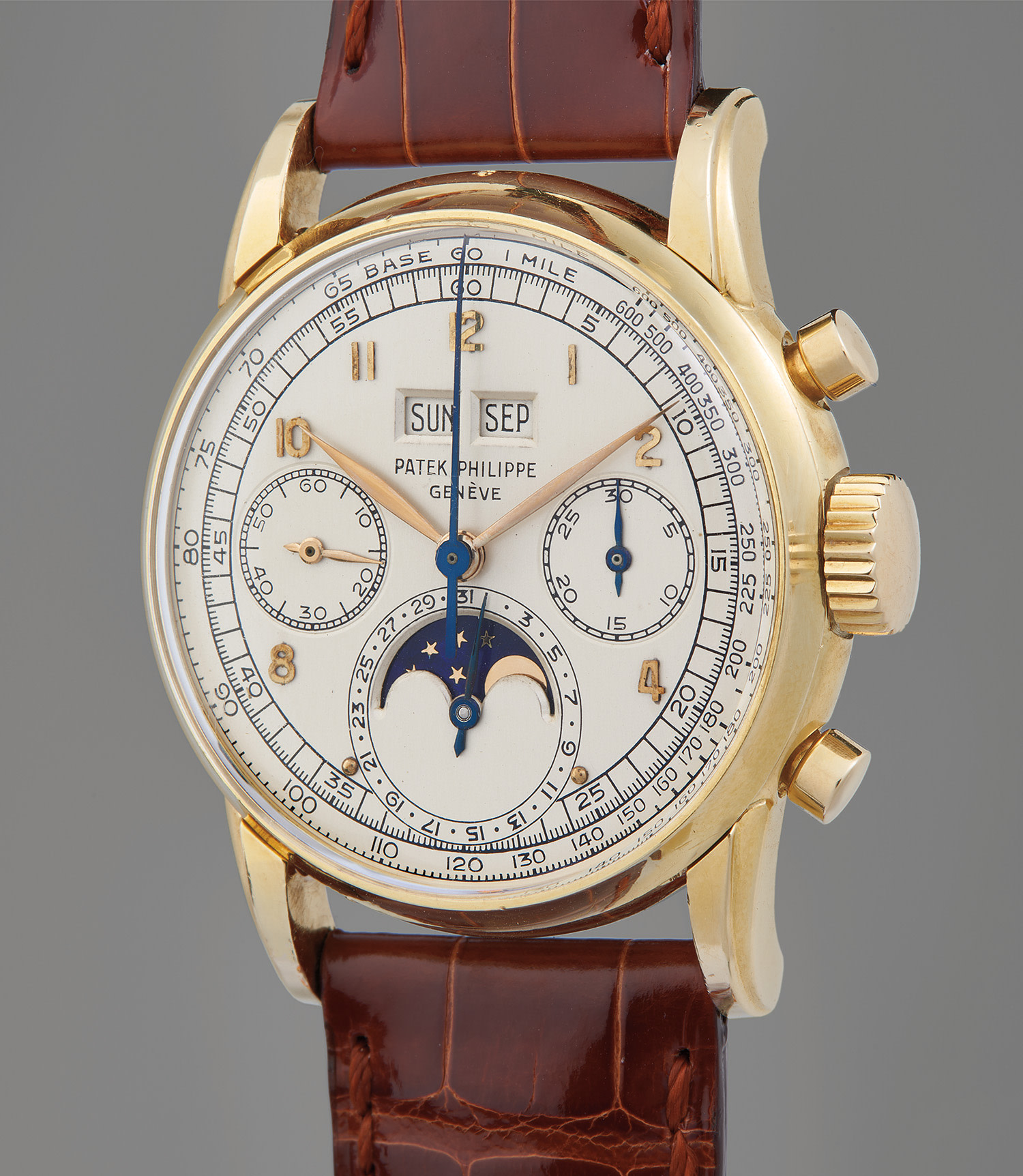



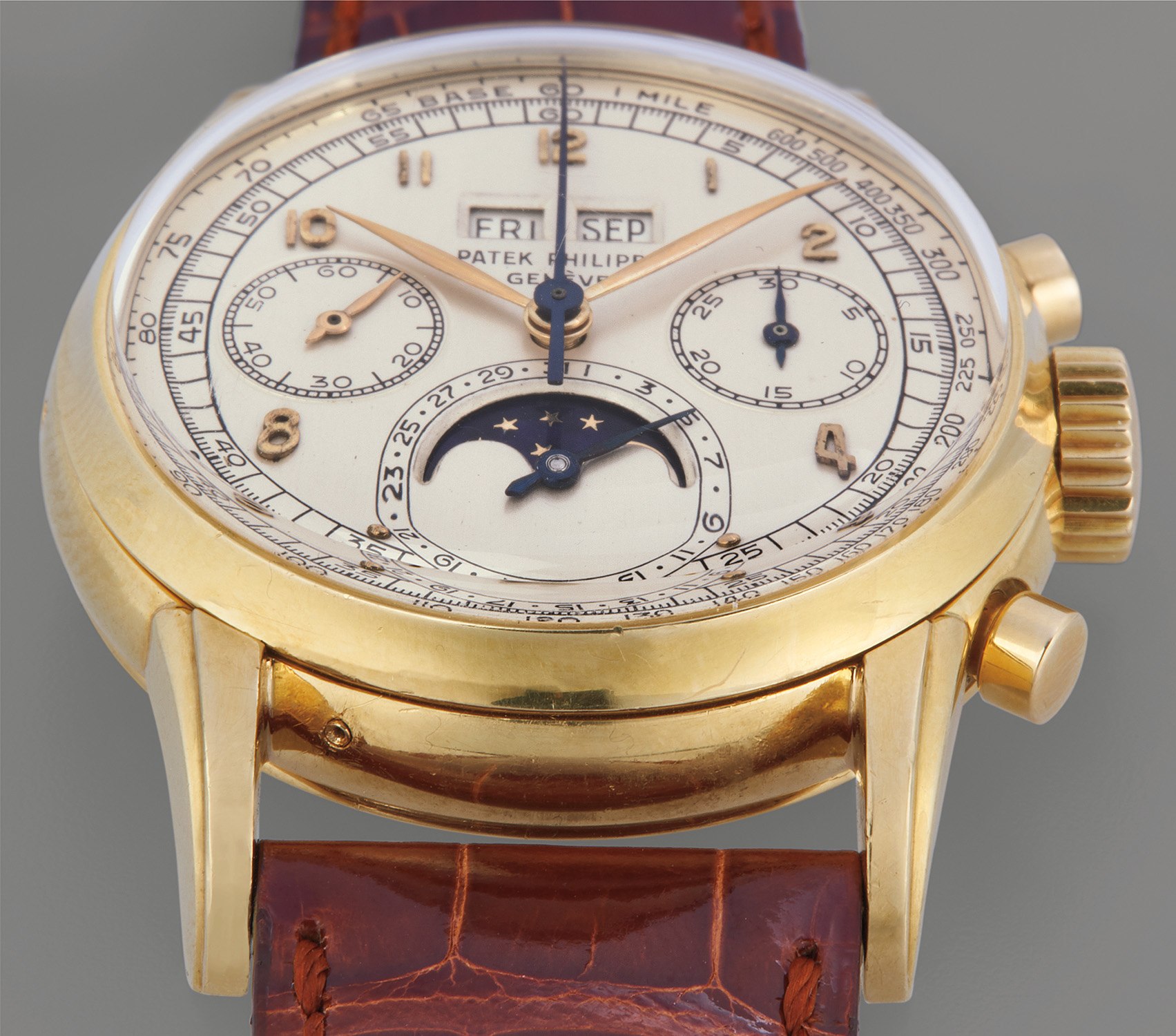
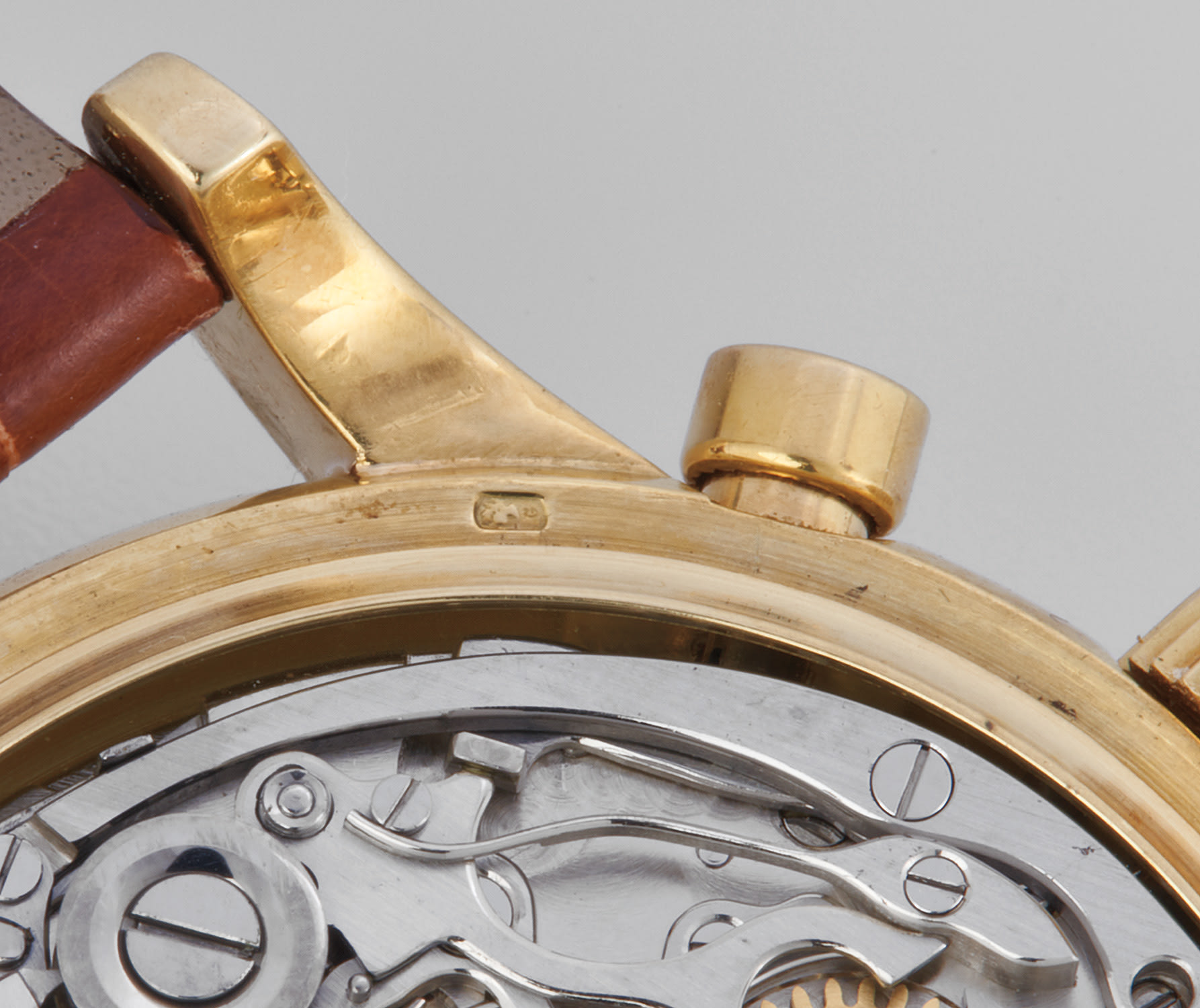
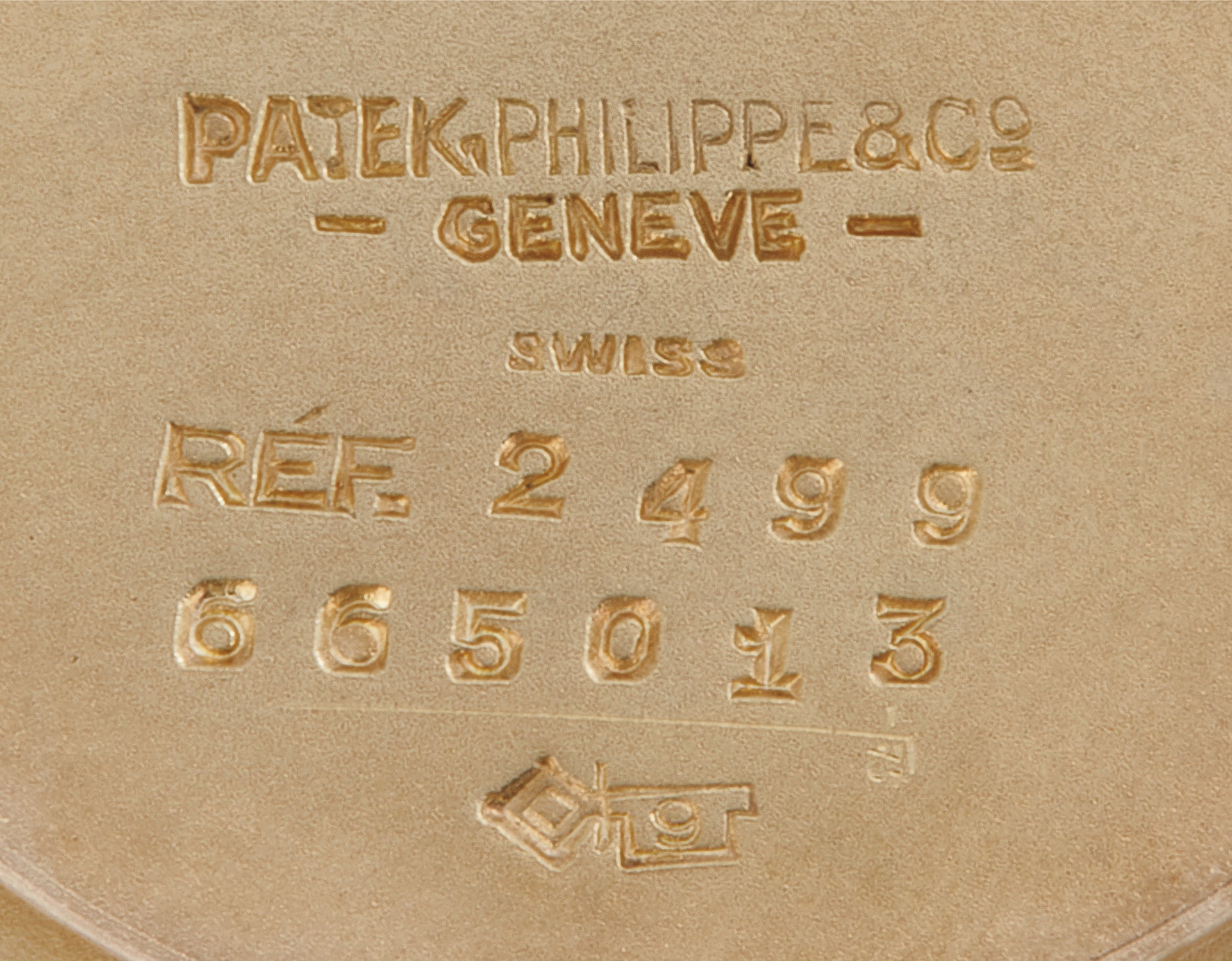
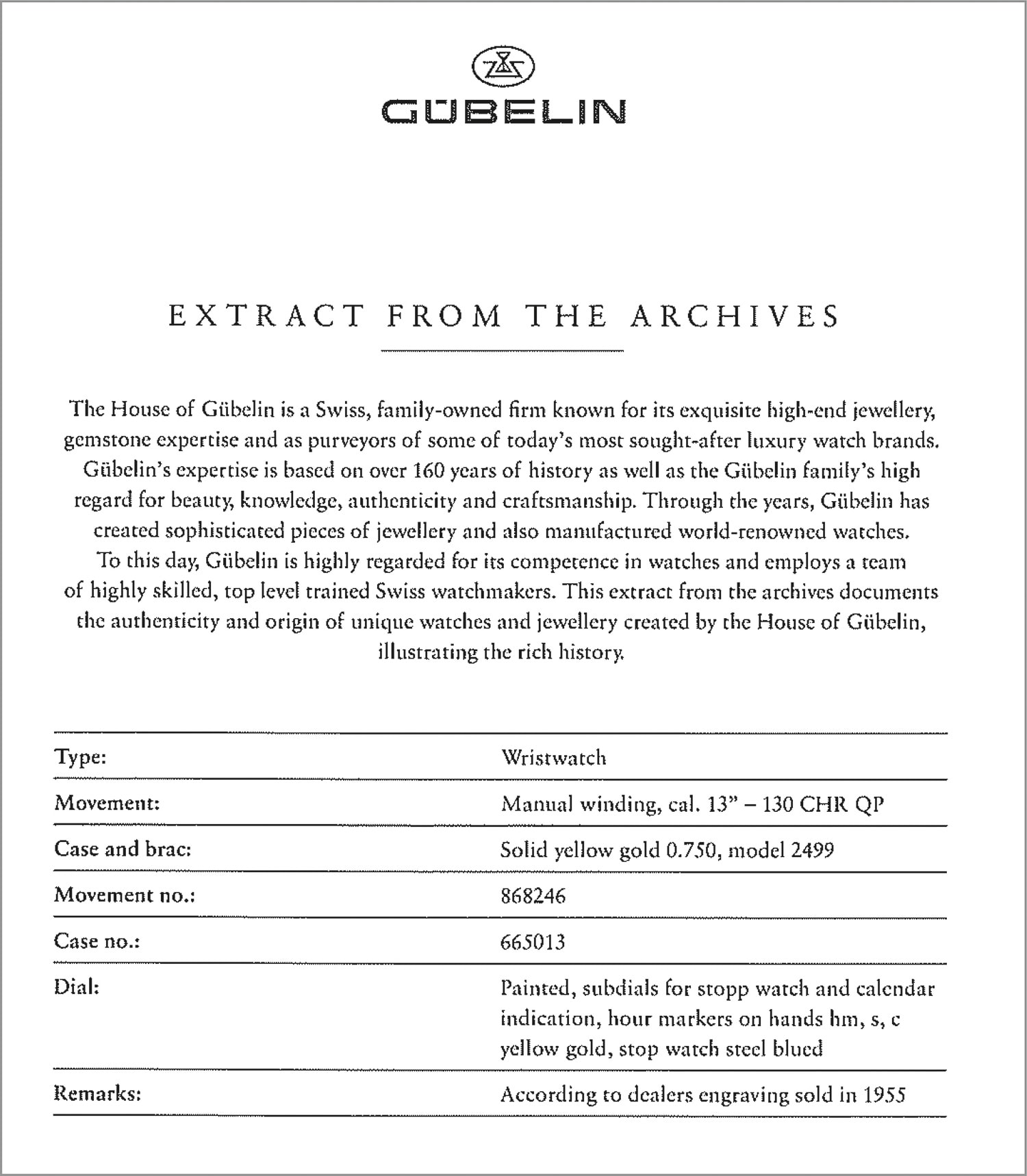
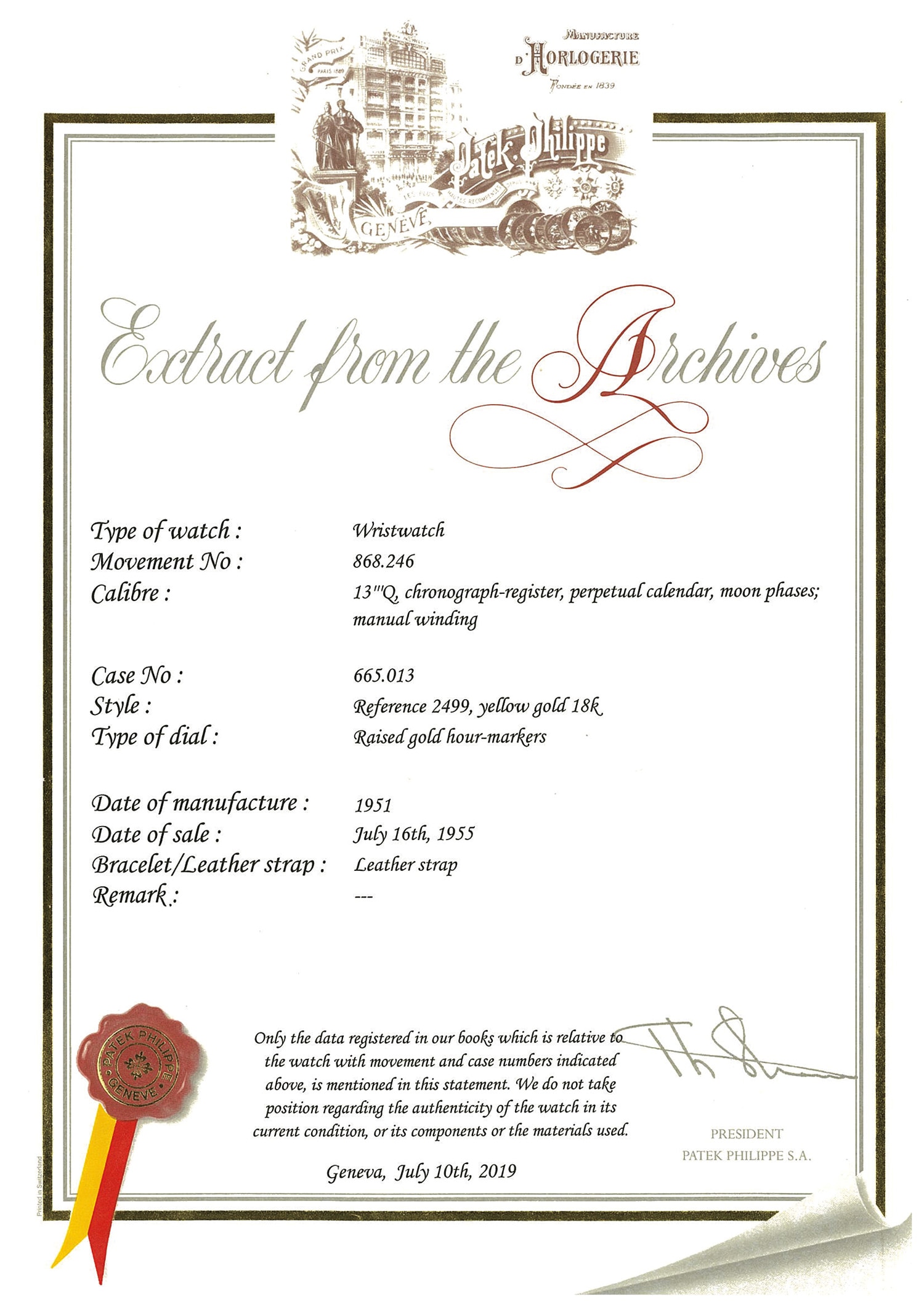
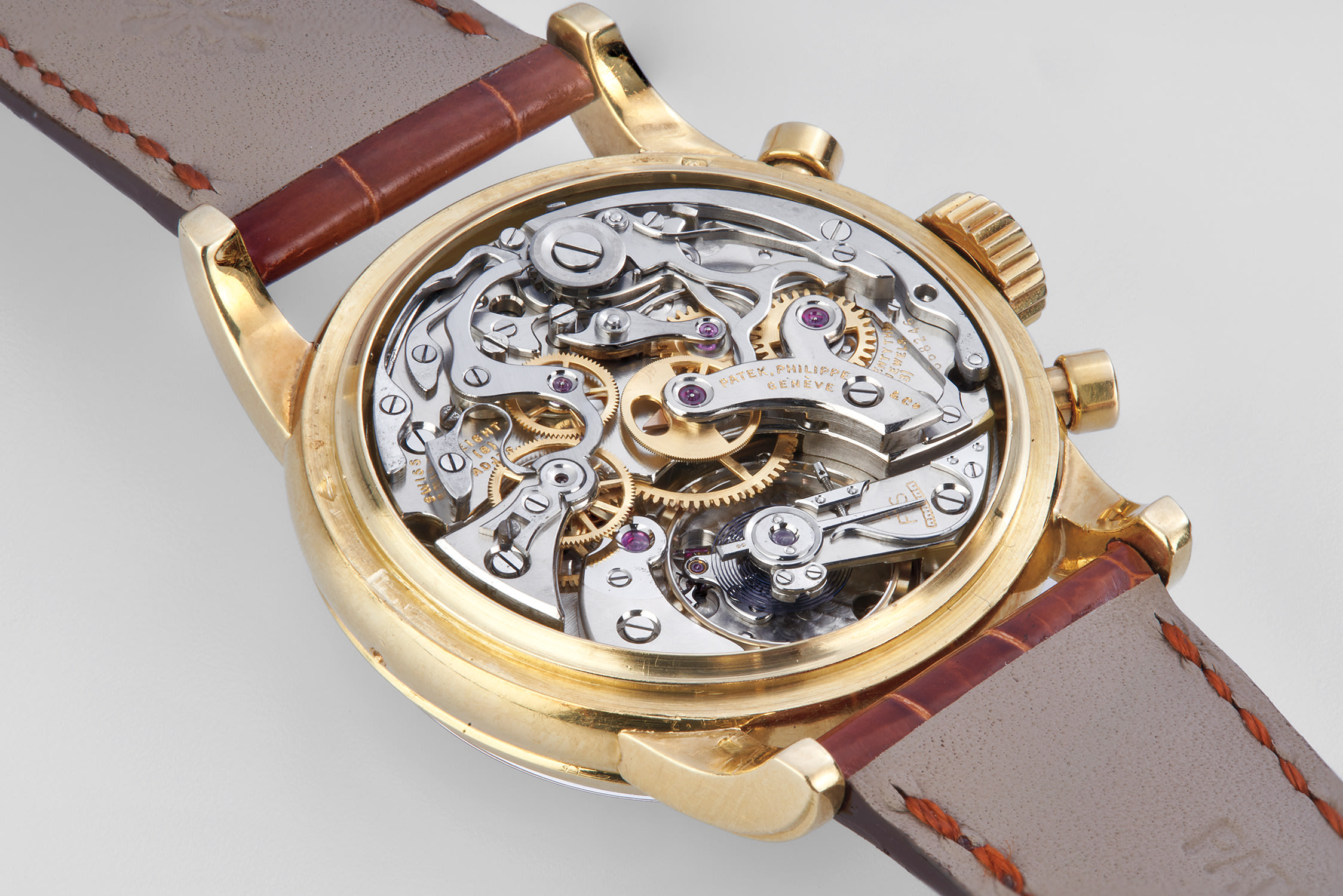










40Σ
Patek Philippe
Ref. 2499
A possibly unique, previously unknown, and extremely well-preserved yellow gold perpetual calendar chronograph wristwatch with moon phase, retailed by Gübelin
Full-Cataloguing
Patek Philippe has long been at the forefront of technological advancements, and the reference 1518 was a confirmation of their founding principles of traditional horology with innovative change. Released in 1941, the ground breaking 1518 was the brand’s first serialized perpetual calendar wristwatch and it became the cornerstone for all other similar complicated wristwatches to follow. Even today, the DNA of the 1518 is found in the brand’s ref. 5270, their current perpetual calendar chronograph offering.
By 1951, a new exuberance was in the air, World War II ended on September 2, 1945 and societies were finally able to shrug of the dust of war. The classic, restrained designs of the 1940s gave way to a new, more modern and expressive aesthetic with larger, more robust wristwatches. Changes made to Patek Philippe’s flagship perpetual calendar chronograph model, were particularly noteworthy, especially with the lugs. Instead of being smoothly integrated into the case, as found in the reference 1518, they were now much more in the spirit of the 1950s. Their design can be described as voluptuous, as they were now prominent sculptures attached to the case and works of art in their own right. The lugs became a signature design element for most of Patek Philippe’s complicated watches to last over half a century, across numerous references.
The initial cases were produced by Emile Vichet SA (case code number 9), and like the present example, featured elongated and downturned lugs with a fat caseback. In time, the design changed and Ed Wenger SA (case code number 1) manufactured cases with more compact lugs with less downturn and a domed case back. Another noteworthy difference is found with the case diameter. Vichet cases measure 36 mm, compared to the 37.5 mm diameter used for Wenger cases.
Patek Philippe produced the reference 2499 until 1985 when it was replaced by the reference 3970. Over its thirty-four year production, the watch evolved with the times and models are divided into four series:
• First series: distinguished by square chronograph pushers, applied Arabic numerals and tachymeter scale.
• Second series: first to use round chronograph pushers, either applied Arabic or baton numerals, and tachymeter scale, to which the present example belongs.
• Third series: round chronograph buttons, applied baton numerals and outer seconds divisions, the tachymeter scale has been removed.
• Fourth series: round chronograph pushers, applied baton numerals and outer seconds division, with sapphire crystal, reference 2499/100.
Vichet produced yellow gold and pink gold cases for reference 2499 and both case versions were made in exceedingly rare quantities. In fact, we know today of only four examples of pink gold 2499’s with Vichet cases, which today are considered amongst the ultimate trophies for any uber collector. Yellow gold examples are similarly rare, in fact not even ten yellow gold examples with the Vichet case are known.
The present watch is the only known Vichet-cased 2499 in the world to appear with round pushers originally delivered by the factory. It is an incredible new discovery that has changed our understanding of the evolution of the 2499. Until its appearance, the Vichet 2499s were all believed to have been exclusively made with square pushers. Sold in 1955, in-depth research, material analysis, and microscopic visualizations in our laboratory in Geneva has confirmed that the case was manufactured at its inception to use round chronograph pushers. Consequently, this watch can be considered a very unusual transitional model that is possibly the very first 2499 to be fitted with round pushers. Fresh to the auction market, it was consigned by the second owner who purchased the watch directly from the family of the original American owner.
It is not known why this very watch was chosen to be the first 2499 to be fitted with round pushers. Consulting with some of the world’s leading scholars on the reference, several theories have been put forward. In the early-to-mid 1950s, Patek Philippe entrusted Wenger to begin production of round pusher cases with enhanced water resistance for the ref. 2499. One theory proposes the possibility that before switching to a new supplier, Patek Philippe sought to determine if Vichet could be successful with a round pusher design. Due perhaps to better water resistance or a preference by the brand for a larger, more prominent case, it was Wenger that was chosen as the supplier with their larger, and more viable water-resistant case design. Since Wenger was already a contractor of cases for Patek Philippe, they won an exclusive contract for the production of the second series of the 2499 with round pushers. With the rise of recreational activities and a more active public following World War II, even the top-of-the-line perpetual calendar chronograph was not spared from evolution. A second theory proposes that this example was a one-of, or trial model, to see how a perpetual calendar chronograph with a water resistant case could perform. This watch was manufactured at approximately the same time as the introduction of the simpler perpetual calendar ref. 2438, which was fitted with a screw-down water resistant caseback - clearly responding to the demands of an active society. Since the early 1940s, Patek Philippe offered a round pusher chronograph in their product line, the ref. 1463. The last theory proposes the possibility that a demanding client of Gübelin, which was in the 1950s one of Patek Philippe’s most important retailers, asked specifically for a round pusher reference 2499. Due to the retailer’s importance, this unique request would be granted by the brand.
The watch is an extraordinary example of the reference 2499 for a multitude of reasons, but foremost for its exceptional state of preservation. The case displays crisp definition to the lugs, retains perfectly preserved hallmarks, and the dial does not show any signs of restoration. The case back interior is lacking any watchmaker marks, remaining in totally original condition with minimal signs of wear. This is another remarkable element of this important piece, as reference 2499 is particularly sensitive to careless polishing, resulting in softer case definition, and hence losing much of its charisma. The inside of the case back also features the recognized hand engravings for the famed and prestigious retailer Gübelin, who has confirmed it was sold by them in 1955 in the accompanying extract from their archives.
In terms of vintage references, the 2499 of any series is a lifetime “must have”. But when a possibly unique version becomes available, not to mention if it is a Vichet-cased specimen, it is an event of such rarity that even the most demanding, and critical collectors should embrace this opportunity with enthusiasm Patek Philippe’s reference 2499 is a milestone wristwatch and the present, early second series example is one of the most exceptional to ever be offered. Its superb aesthetics, historical importance, and stellar originality present a rare opportunity for the most discerning collector.
Patek Philippe
Swiss | 1839Since its founding in 1839, this famous Geneva-based firm has been surprising its clientele with superbly crafted timepieces fitted with watchmaking's most prestigious complications. Traditional and conservative designs are found across Patek Philippe's watches made throughout their history — the utmost in understated elegance.
Well-known for the Graves Supercomplication — a highly complicated pocket watch that was the world’s most complicated watch for 50 years — this family-owned brand has earned a reputation of excellence around the world. Patek's complicated vintage watches hold the highest number of world records for results achieved at auction compared with any other brand. For collectors, key models include the reference 1518, the world's first serially produced perpetual calendar chronograph, and its successor, the reference 2499. Other famous models include perpetual calendars such as the ref. 1526, ref. 3448 and 3450, chronographs such as the reference 130, 530 and 1463, as well as reference 1436 and 1563 split seconds chronographs. Patek is also well-known for their classically styled, time-only "Calatrava" dress watches, and the "Nautilus," an iconic luxury sports watch first introduced in 1976 as the reference 3700 that is still in production today.